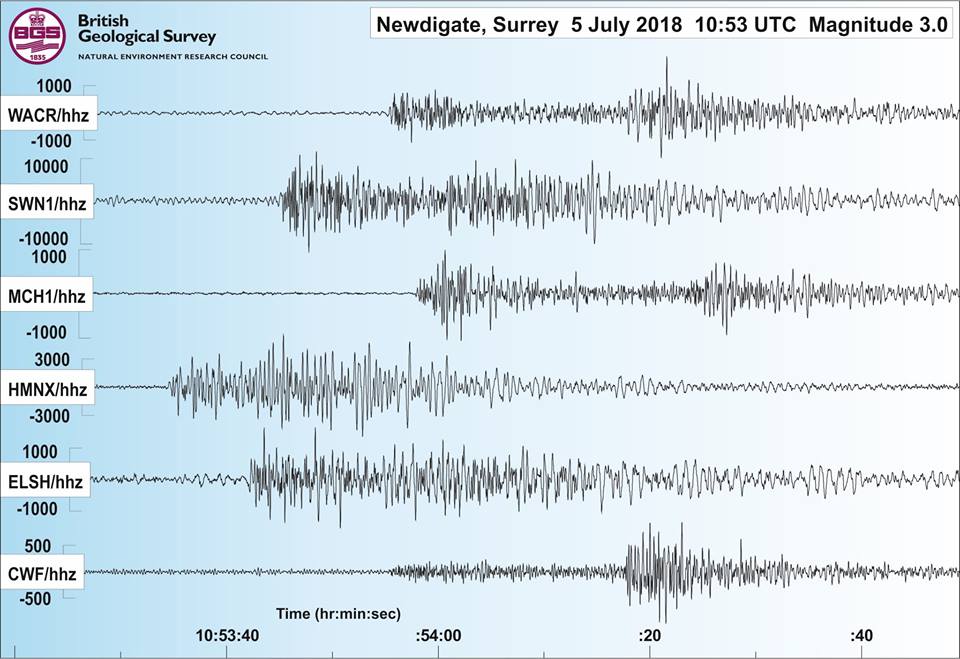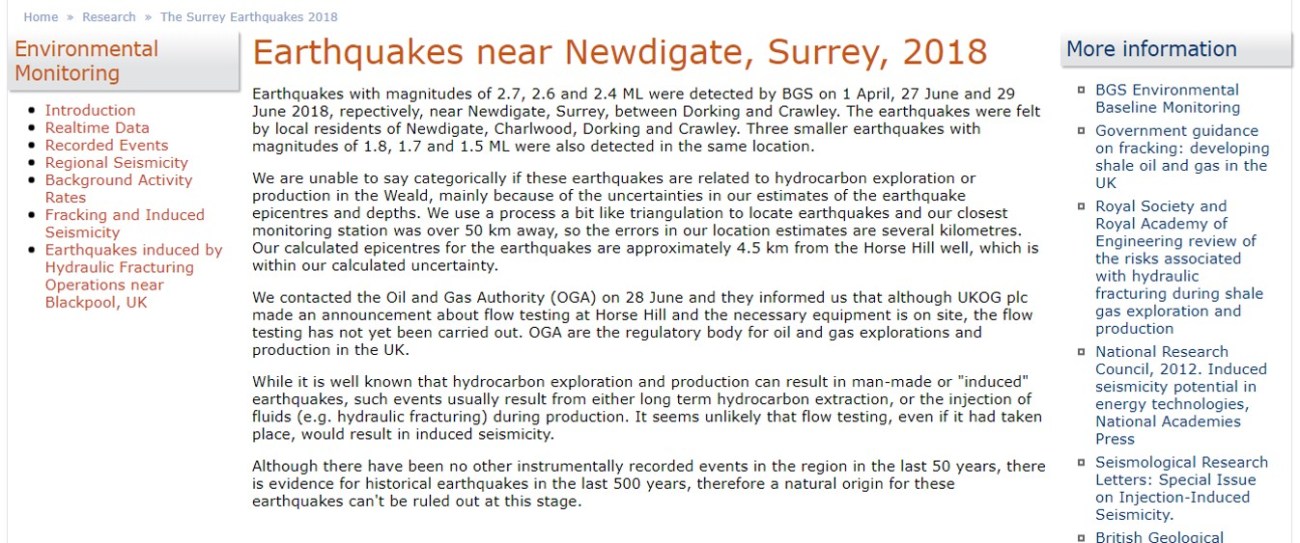
The seventh earthquake in just over three months was recorded in part of Surrey at midday today.
It was the most powerful earthquake so far, with a magnitude of 3.1, the British Geological Survey (BGS) confirmed.
A residents group has urged the BGS to investigate any possible links with the local oil and gas industry.
Brockham Oil Watch said in a letter to the BGS:
“We think that serious questions should be asked and investigated, especially in connection with the two [oil and gas] sites nearest to the epicentres: Brockham and Horse Hill.”
Their call was supported by the Green Party MEP for the area, Keith Taylor. But UK Oil and Gas, the main investor at Horse Hill, near Gatwick, said there had been no sub-surface work since 2016. The operator of the Brockham site, near Dorking, did not respond to our request for comment.

This morning’s earthquake was felt by people in Newdigate, Dorking, Horley and Charlwood. They reported creaking buildings, shaking ground and moving lights.
The BGS has confirmed that this morning’s quake followed three previous ones recorded since 1 April 2018. They had a magnitude of 2.7, 2.6 and 2.4. There were also three smaller quakes of 1.5-1.8 magnitude in the same area over the same period, it added.
Before the recent seismic activity, Surrey had been earthquake-free for 50 years.
After the previous earthquake on 29 June 2018, the BGS said on its website:
“We are unable to say categorically if these earthquakes are related to hydrocarbon exploration or production in the Weald, mainly because of the uncertainties in our estimates of the earthquake epicentres and depths.”

British Geological Survey web page
The BGS said it was well known that hydrocarbon exploration and production could result in man-made or induced earthquakes. They were usually linked to long-term extraction or injection of fluids, such as fracking or waste disposal, it said.
Flow testing is due to begin at Horse Hill. But the BGS said it was unlikely this would result in induced seismicity.
At Brockham, there is an injection well, which is used to dispose of produced water. The Brockham site was closed for much of 2016 and 2017, resuming production in spring 2018.
Data from the Oil and Gas Authority shows that water reinjection at Brockham began for the first time in March 2018.
Brockham Oil Watch said:
“The convergence of the Horse Hill flow test, resumed operations at Brockham and the earthquakes is at the very least puzzling.
“We think that there are too many unknowns and that the link should be thoroughly investigated before the drilling and injection can continue.”
“Well integrity should be tested as well to check if the earthquakes didn’t cause damage that could lead to environmental pollution.
“This is critically important at a time when Surrey is facing a proliferation of applications for hydrocarbon exploration and production, including in some of its most precious areas of outstanding natural beauty.”
Keith Taylor, the Green Party MEP for south east England, said:
“Details may be scant at the moment, but the seismic activity in an area where unconventional fossil fuel drilling and testing is active is clearly extremely concerning. It is also unprecedented in the Weald in the last half a century. The links between earthquakes and the unconventional onshore oil and gas drilling industry are well established.”
“I wholeheartedly support the calls for the British Geological Survey to further investigate this activity and would add that it seems only sensible to put a moratorium on any oil and gas activity in the region until the results of the investigation are clear.”
“The oil gas industry must surely agree that any connection between onshore oil and gas drilling in Surrey and Sussex and the recent spate of earthquakes can only be confirmed or dismissed after it has been independently investigated.”
Stephen Sanderson, executive chairman of UK Oil and Gas, said:
“There has been no subsurface activity at Horse Hill since March 2016.
“We are currently preparing to conduct a flow test using a crane. No flow has yet taken place. “We are not drilling and operations utilise a crane not a drill rig.
“We should stress that the work we are planning has the same seismic impact as any type of construction work requiring the use of such a crane. We would also like to point out that there was no recorded seismicity associated with our 2014 drilling and 2016 flow testing, nor are we aware that any of the other 80 plus wells drilled or flowed in the Weald are associated with any seismicity.
“Furthermore as the BGS have stated, the source of this seismicity is related to a deep seated basement fault at around 5.5 km below surface, 4.5 km deeper than our activities at Horse Hill.”
DrillOrDrop asked Angus Energy for more details on water reinjection at Brockham and its view of any link between local seismic events and oil and gas activity. This post will be updated with any response.
Timeline of largest earthquakes in the same area of Surrey
1 April 2018: 2.7 magnitude
27 June 2018: 2.6 magnitude
29 June 2018: 2.4 magnitude
5 July 2018: 3.1 magnitude
Also three smaller earthquakes of 1.8. 1.7 and 1.5 in same location.
Categories: Regulation

bip
bip
bip [bip,bip,bip]
TING
https://dwarshuis.com/earthquakes-groningen-gas-field/visualisation/
All those industry LHV’s giving all those manholes a hammering again?
Not so much ripples in the coffee cups, more like fractures in the lithosphere?
And a fogggy doo doo rolling up from Poole harbour too too?
Or that giant fracking monsters on the prowl again?
So what colour on the fracking traffic light seismic warning system lit up yesterday please? Round here a 3 or more means RED LIGHT which means:
STOP WORK and RUN FOR THE HILLS!
Or something like that.
[Comments removed by moderator]
Interesting to see 27 earthquakes throughout the UK over the last 30 days…from the highlands of Scotland to Dumfries & Galloway, County Durham, Lincolnshire, Lancashire, Wales, Bristol Channel…etc.
https://earthquakes.bgs.ac.uk/earthquakes/recent_uk_events.html
I suppose DoD would invite its readers to believe that these are all the result of the oil industry and that mother nature has no part to play?
When will the UK wake up. Drilling is dangerous. The government refuse to acknowledge long term harm to the land and environment.
Interesting that, despite a recent RNS stating UKOG started flow-testing on 27th June (quakes felt on 27th, 29th & July 5th) Stephen Sanderson denied they’d started…???
They are the first since 3 tiny ones nr Billingshurst in 2005 : before that there was one in Lewes (1975) and Dorking (1551).
So, R8LMX, if you lived in the area wouldn’t you like to find out what was going on? And a natural first stage is to work out what has changed recently… There’s only one answer to that.
Pat…i live in the area of the 27 earthquakes that have occurred in the last 30 days and i don’t draw the tenuous conclusions that others choose to.
What caused the frequent quakes in the Highlands of Scotland? Or in County Durham or Lincolnshire? Sure as hell wasn’t a crane used by UKOG or an oil production site that has been operational for 30 years.
Not unconventional, not drilling, not flow testing, not fracking, not chalk, much deeper, what a none story…..
Why not look at quarrying? Just as ridiculous.
We are all very fortunate that Keith Taylor will soon be out of a job. Unfortunately he will no doubt receive a huge pension bung at our expense like all the rest of the useless MEPs.
Did you actually read the above Paul? It said :
“At Brockham, there is an injection well, which is used to dispose of produced water. The Brockham site was closed for much of 2016 and 2017, resuming production in spring 2018.” and…
“Data from the Oil and Gas Authority shows that water reinjection at Brockham began for the first time in March 2018.”
On what basis do you deny the accuracy of that report?
More quakes are started from injection of wastewater than fracking itself (from international studies) btw.
True. But fracking involves gas which is going to lead to pollution of water, farm lands, extending to milk from cows grazing etc.
The biggest polluters of our water and land are farmers, especially dairy farmers. This is why our rivers and secondary water courses are failing. Agriculture is exponentially worse for ater and land pollution than any other single impact. Are you going to stop eating?
So let’s add still more pollution?
😴😴😴
Is that an amber light GBK
The fact that re-injection of waste water started in March of this year, just before this recent run of earthquakes, is perhaps the first place to look. The first earthquake for 50 years in the Weald happened on 1st April. Re-injection is widely accepted as the reason for Oklahoma becoming the earthquake capital of the USA, and may be the cause here. Also somewhat telling that the operators of the Brockham site, where the re-injection is taking place, refused to comment.
If this is shown to be the cause, it would have very grave implications for the unconventional onshore oil and gas industry, as the only way this industry can ever dispose of the gigantic quantities of radioactive waste water it creates is by re-injection.
The reinjection of the produced water from one small well at 760m depth would do very little to cause any effect 3200m deeper down where the BGS interpret the focus of activity. The reinjection of the water fraction of one relatively tiny well has no analogue whatsoever in the Oklahoma waste disposal wells. They chuck down volumes and rates which are several orders of magnitude greater than this for decade after decade and even then only a handful of those wells give seismicity. It certainly does need checking with local microseismic investigation but it’s pretty unlikely.
The two latest earthquakes recorded by the BGS on the 18th July have been measured as between 0.5km and 2km in depth so may be related to reinjection of water. Indeed the BGS admits that the previous earthquakes could have also have been at this depth. These were measured before the new monitoring stations were set up at Russ Hill and Horse Hill so were subject to more inaccuracies in relation to depth. http://earthquakes.bgs.ac.uk/research/SurreyEarthquakes2018.html